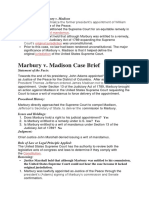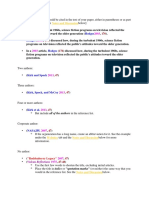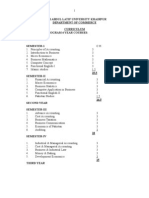Blue Book - Cheatsheet (2006)
Blue Book - Cheatsheet (2006)
Uploaded by
Taannyya TiwariCopyright:
Available Formats
Blue Book - Cheatsheet (2006)
Blue Book - Cheatsheet (2006)
Uploaded by
Taannyya TiwariOriginal Description:
Copyright
Available Formats
Share this document
Did you find this document useful?
Is this content inappropriate?
Copyright:
Available Formats
Blue Book - Cheatsheet (2006)
Blue Book - Cheatsheet (2006)
Uploaded by
Taannyya TiwariCopyright:
Available Formats
ELQ BLUEBOOK CHEAT SHEET
Last Updated Fall 2006
General Tips
* Keep in mind the general principles of Bluebooking: clarity, consistency, and brevity. * Use the index, and use it often. Use tabs in your book. Search old issues for examples. * Page numbers work like this: * Use en dash () not hyphen (-) to indicate sequence of pages, years, and when connecting two proper nouns [Insert Menu > Symbol > Special Characters]. * Only repeat the last two digits (or one, where applicable). Engel & Saleska, supra note 1, at 20307 (discussing U.S. relations with China).
Cases
* Case names are italicized when used in textual sentences in both the main text and footnote. * Full case names are not italicized when used as citations in footnotes. * Short forms for cases are italicized. Only use if the last full cite was within 5 footnotes otherwise use the full form (Exception: if you have a bunch of Id.s in a row, you do not need to insert a full cite every fifth footnote). * The comma after an italicized case name in a footnote is not italicized.
1 2
Smith v. Jones, 123 U.S. 510 (2000). The Court later expanded on this doctrine in Night v. Day, 234 U.S. 650 (2002). 3 Smith, 123 U.S. at 515.
Statutes & Regulations
* Always cite to U.S.C., not U.S.C.A. or U.S.C.S. unless it has been enacted/amended since the latest publication of U.S.C. * Date for U.S.C. is always (2006). * When referring to an act by name that is scattered throughout various sections of the code, or when referring to historical fact of the acts enactment, use the Public Law Number. Its helpful to add a parenthetical containing the location in the U.S.C. where it is codified if possible. Energy Policy Act of 2005, Pub. L. No. 109-58, 100 Stat. 567 (codified at 1 U.S.C. 900999). * Use if you are citing to multiple sections [Note: no space between symbols, but remember to put a space between the second and the numeral]. * Do not use et seq. even if the author did look up the full range of sections. * To indicate a range of sections, use all of the digits, unlike page numbers. CERCLA, 42 U.S.C. 96019675, 9700 (2006). * You can use either the Acts name and original section number, the U.S.C. section number, or parallel cites depending on the context. * Only use short form if the full citation occurs within 5 previous footnotes. * Do not use at before in a short cite. 1. National Environmental Policy Act of 1969 102, 42 U.S.C. 4332 (2006). 2. NEPA 102, 42 U.S.C. 4332. 3. 42 U.S.C. 4332. [Use this short form if the text corresponding to the footnote provides the omitted information, for example: NEPA section 102 provides ] * C.F.R. [Code of Federal Regulations] is published every year in four parts: Titles 116: January 1. Titles 1727: April 1.
Macintosh HD:Users:mbaumhefner:Desktop:BB
Titles 2841: July 1. Titles 4250: October 1. So, if today were January 25, 2007, the appropriate date for Titles 1 through 16 would be (2007), while the appropriate date for all other titles would be (2006).
Law Reviews, Journals, & Other Periodical Materials
* Use & to join two author names; do not use & in article titles. * Use Table 14 for the appropriate abbreviation of the journal name. * Indicate where the source is a student-written comment/note. * Short forms: OK to use supra after the first cite; doesnt have to be within 5 footnotes. Author Name & Couthor Name, Title of the Article in Italics and Not Small Caps, 30 NAME OF L. REV. IN SMALL CAPS 645, 64647 (2005). Jane Doe, Comment, Why I Love Justice Scalia , 1 J. G ENDER L. & JUSTICE 55 (2006).
Books & Reports
* Note: no comma separating the title from the pincite, or the pincite from the date. * Use & to join two author names; do not use & in titles. * Special rules for institutional authors, editors and translators look em up! * No publisher information unless there has been more than one edition. AUTHOR NAME, TITLE OF BOOK 17 (1959). AUTHOR NAME, INSTITUTION OR AGENCY NAME, TITLE OF REPORT 1012 (1973).
Internet
* Remove all hyperlinks! * The URL goes at the end of other source information, without an introductory phrase like at * However, if the source is available in a traditional printed medium and the Internet address is just providing a parallel citation to help the reader obtain the item, then the URL should be preceded by a comma (not italicized) and the phrase available at as in available at http://www.webaddress.com * When citing an Internet source that does not exist in a traditional printed format, use the citation format of the analogous type of printed source to the extent possible (including title, page numbering, and publication date) followed by the URL. THE NATURE CONSERVANCY, CONSERVATION EASEMENT W ORKING GROUP REPORT 23 (2005), http://www.nature.org/aboutus/howwework/conservationmethods/privatelands/conservatio neasements/files/easements_report.pdf. * If the source does not have an identifiable publication date, use (last visited [date]) at the end of the citation CITY OF BERKELEY, STRATEGIES FOR I SSUING MORE PARKING TICKETS 34 (2004), available at http://www.ci.berkeley.gov/parkingtix.html. Web Sudoku, http://www.websudoku.com (last visited Jan. 25, 2006). * See Rule 18 for more details and examples.
Signals
* Always use a signal ( see, see, e.g., etc.) unless: there is a direct quote in the text, or the title of the work is cited in the text. * When using see, e.g., the first comma is italicized but the second comma is not. * When using signals do not use a ; followed by an and to join cites just use a ; followed by another cite or followed by another signal, such as see and then the cite. * No comma after see / see generally / id.
Macintosh HD:Users:mbaumhefner:Desktop:BB
* Do not italicize a signal if it is used as a verb in a textual sentence [e.g. For a discussion of the dangers of pesticides, see Rachel Carson ].
Use of Id. and Supra.
* Use id. whenever the citation is the same as in the preceding footnote, as long as the preceding footnote contains only one source. * When a book, journal article, or report has been fully cited before and id. is not appropriate, use supra, cross-referenced to the note with the full cite (see Bluebook Rule 4.2(a) for examples). * The period in id. is italicized. * For all id. cites: enclose cross-references with brackets (e.g., Id. [54]) we remove them later. * For all supra cites, use cross-references, but you dont need brackets around them.
1
Dinah Bear, NEPA At 19: A Primer on an "Old" Law with Solutions to New Problems, 19 ELR 10060-61 (1989). 2 Id. [1] 3 CHARLES ALAN WRIGHT & ARTHUR R. MILLER, FEDERAL PRACTICE & PROCEDURE 4457 (2006) 4 Bear, supra note 1, at 10060. 5 WRIGHT & MILLER, supra note 3.
Other Formatting Comments:
* Dont abbreviate words that the Bluebook does not abbreviate * Block quotes if 50+ words this goes for quotes in footnotes too * Punctuation is always inserted inside the quotation mark * Insert a comma at the end of a list (before the and) [e.g., One, two, and three.] * Do not use double spaces anywhere in the document (i.e., use a single space after a period)
Macintosh HD:Users:mbaumhefner:Desktop:BB
You might also like
- Gay Gay FormatDocument7 pagesGay Gay FormatLife Camp Tv83% (6)
- OSCE Common Drugs To Explain (Oscestop) - UnlockedDocument2 pagesOSCE Common Drugs To Explain (Oscestop) - Unlockedhannahkim55No ratings yet
- Gasoline and Antifreeze Planning:: Dispute Resolution: Beyond The Adversarial Model Second Edition. P. 299Document8 pagesGasoline and Antifreeze Planning:: Dispute Resolution: Beyond The Adversarial Model Second Edition. P. 299Mark Michael StrageNo ratings yet
- YELL IRAC Method Example For EssayDocument10 pagesYELL IRAC Method Example For EssayNetaniaLim100% (1)
- A Bluebook Guide For Law StudentsDocument21 pagesA Bluebook Guide For Law StudentsPrithvi Reddy100% (2)
- The Bluebook: A Uniform System of CitationDocument7 pagesThe Bluebook: A Uniform System of CitationKyle Janvier VillaluzNo ratings yet
- Detailed Contracts II Outline - Powers - Spring 2011Document97 pagesDetailed Contracts II Outline - Powers - Spring 2011Thomas J. Holmes III100% (1)
- Rosenbaum FrankfordDocument334 pagesRosenbaum FrankfordJorge Luis Rivera AgostoNo ratings yet
- Outline Professional Responsibility LawDocument16 pagesOutline Professional Responsibility LawMeg2good4u100% (4)
- New York Course Constitutional Law: Professor Erwin ChemerinskyDocument58 pagesNew York Course Constitutional Law: Professor Erwin ChemerinskyJae Yong Lee100% (5)
- Con Law Exam 06Document7 pagesCon Law Exam 06cstokes85No ratings yet
- Constitutional Law OutlineDocument107 pagesConstitutional Law OutlineAram Abgaryan100% (2)
- The Law School ManifestoDocument14 pagesThe Law School Manifestoqueenroevi0% (1)
- Chart - ComparisonDocument9 pagesChart - ComparisonCraig ThompsonNo ratings yet
- FL Con Law OutlineDocument157 pagesFL Con Law Outlineomaidadelgado100% (3)
- Closed Universe MemoDocument5 pagesClosed Universe MemoLarry GrahamNo ratings yet
- Glannon Guide To TortsDocument7 pagesGlannon Guide To TortsSportzFSUNo ratings yet
- Writing Skills and TechniquesDocument2 pagesWriting Skills and TechniquesANJALI MISHRANo ratings yet
- Student-Authored Note Guide 2021: Ornell AW EviewDocument19 pagesStudent-Authored Note Guide 2021: Ornell AW EviewJamal La RoseNo ratings yet
- Civil Procedure Handout - Gilbert Law Summaries - Richard D. FreerDocument25 pagesCivil Procedure Handout - Gilbert Law Summaries - Richard D. FreerHookedOnTronicsNo ratings yet
- Citation Study GuideDocument15 pagesCitation Study GuideRuben Hilburn100% (1)
- Bluebook For JournalsDocument69 pagesBluebook For JournalsAshley MeredithNo ratings yet
- 1L Contracts Outline (2 Semesters)Document7 pages1L Contracts Outline (2 Semesters)Natalie BakerNo ratings yet
- Contracts Case Brief ChartDocument40 pagesContracts Case Brief Chartnlandsmanuchicagoedu100% (1)
- Case Summary of Marbury V MadisonDocument2 pagesCase Summary of Marbury V MadisonGilly Mae Gallego RPhNo ratings yet
- Because-Centered IRACDocument2 pagesBecause-Centered IRACMcKayNo ratings yet
- Torts BAR OutineDocument90 pagesTorts BAR OutineKat-Jean FisherNo ratings yet
- List of The Canons of Statutory InterpretationDocument2 pagesList of The Canons of Statutory InterpretationIan Ghrist0% (1)
- Carmella - Property - Spring - 2019Document49 pagesCarmella - Property - Spring - 2019Ian Wardell100% (1)
- Civil Procedure OutlineDocument53 pagesCivil Procedure OutlineCory BakerNo ratings yet
- Bluebook (19th Ed.) Citation Format ExamplesDocument1 pageBluebook (19th Ed.) Citation Format ExamplesSweta Rao100% (1)
- Fundamentals of Legal Research by Ervin H. Pollack. The FoundatiDocument5 pagesFundamentals of Legal Research by Ervin H. Pollack. The FoundatiLeizza Ni Gui DulaNo ratings yet
- Business Associations OutlineDocument4 pagesBusiness Associations OutlineJenna AliaNo ratings yet
- The Ultimate Guide To Law School Cases:: How To Read Cases in & Summarize Them inDocument30 pagesThe Ultimate Guide To Law School Cases:: How To Read Cases in & Summarize Them inUnjul ZenNo ratings yet
- Civil Procedure OutlineDocument10 pagesCivil Procedure OutlineMichael CantorNo ratings yet
- Law Nerds - AnalysisDocument5 pagesLaw Nerds - AnalysisVictor BrownNo ratings yet
- Hearsay Chart: Rev. July 2018Document5 pagesHearsay Chart: Rev. July 2018Fernand CastroNo ratings yet
- Family Law OutlineDocument60 pagesFamily Law OutlineAmanda SterlingNo ratings yet
- Awesome Civ Pro OutlineDocument78 pagesAwesome Civ Pro Outlinebeenishzahid100% (1)
- Con Law II PPT OutlineDocument76 pagesCon Law II PPT OutlineNija Anise BastfieldNo ratings yet
- Bar Exam Digest On WebsiteDocument56 pagesBar Exam Digest On Website李思儀No ratings yet
- Write A Good Law School ExamDocument9 pagesWrite A Good Law School ExamNel TongNo ratings yet
- Writing A Seminar PaperDocument17 pagesWriting A Seminar Paperfunky doleNo ratings yet
- Property Case OutlineDocument66 pagesProperty Case OutlineMissy MeyerNo ratings yet
- How To Write A Case Brief For Law SchoolDocument6 pagesHow To Write A Case Brief For Law SchoolRamona SantelicesNo ratings yet
- Erie Flow ChartDocument1 pageErie Flow Chartsmokyroom26No ratings yet
- (NEW) (NEW) (Short & Happy Guides) Richard D. Freer - A Short & Happy Guide To Civil Procedure-West AcademicDocument176 pages(NEW) (NEW) (Short & Happy Guides) Richard D. Freer - A Short & Happy Guide To Civil Procedure-West Academicm.fan100% (1)
- Parol Evidence Flow ChartDocument1 pageParol Evidence Flow ChartHeidi HyunNo ratings yet
- 3l Feb 2 2017 The Bar Exam With CF and Il Slides UpdatedDocument75 pages3l Feb 2 2017 The Bar Exam With CF and Il Slides UpdatedLeah Caminong MaasinNo ratings yet
- Con Law I Outline RossDocument79 pagesCon Law I Outline RossCourtney LaShawn HowardNo ratings yet
- Developing A Game Plan For The Bar ExamDocument22 pagesDeveloping A Game Plan For The Bar Examhailglee1925No ratings yet
- Freer On Corporations BarbriDocument38 pagesFreer On Corporations BarbriJEL100% (1)
- Essay SubjectsDocument101 pagesEssay Subjectsfender4100% (1)
- Blue TipsDocument4 pagesBlue Tipsmaggie305No ratings yet
- The Sources That You Use Should Be Cited in The Text of Your PaperDocument8 pagesThe Sources That You Use Should Be Cited in The Text of Your PaperJoanne RichardsNo ratings yet
- APA Style Referencing GuideDocument8 pagesAPA Style Referencing GuidePrashnil DassNo ratings yet
- APA Citation Style - AppendixBDocument13 pagesAPA Citation Style - AppendixBnaroNo ratings yet
- 820.9.5X MLA Style (8th Edition) - S17Document6 pages820.9.5X MLA Style (8th Edition) - S17project.stars.idolNo ratings yet
- Apa6 QRCDocument2 pagesApa6 QRCtechsuptNo ratings yet
- IjmgrDocument5 pagesIjmgrjonstark8No ratings yet
- APA Citation StyleDocument8 pagesAPA Citation Styleriderallison489No ratings yet
- Vimal Chandra Grover Vs Bank of India On 26 April, 2000Document8 pagesVimal Chandra Grover Vs Bank of India On 26 April, 2000Taannyya TiwariNo ratings yet
- Ba Bba IV Sem Winter TimetableDocument2 pagesBa Bba IV Sem Winter TimetableTaannyya TiwariNo ratings yet
- National Seminar ON Company Law: The UniversityDocument2 pagesNational Seminar ON Company Law: The UniversityTaannyya TiwariNo ratings yet
- Amended Time Table For Pil: ConsultationDocument1 pageAmended Time Table For Pil: ConsultationTaannyya TiwariNo ratings yet
- E Flyer Arbitration 25may13Document1 pageE Flyer Arbitration 25may13Taannyya TiwariNo ratings yet
- A S Shenoy Paper Child AdoptionDocument6 pagesA S Shenoy Paper Child AdoptionTaannyya TiwariNo ratings yet
- Steel Panthers - MBT Game GuideDocument205 pagesSteel Panthers - MBT Game GuideSeth VanEyckNo ratings yet
- XGC180 Plano Electrico PDFDocument49 pagesXGC180 Plano Electrico PDFGustavo Rodriguez100% (2)
- Types of Nuclear ReactorsDocument19 pagesTypes of Nuclear ReactorsUgur GuvenNo ratings yet
- 1055 OperacionDocument220 pages1055 Operacionreidco tallerkm16No ratings yet
- DCCN 3Document68 pagesDCCN 3Nati ZemeteNo ratings yet
- Isolation of gDNA From Goat Spleen-1Document2 pagesIsolation of gDNA From Goat Spleen-1namratabaruah77No ratings yet
- Schlage S-6800 ManualDocument32 pagesSchlage S-6800 Manualgeotechsoil1100% (1)
- Devoir de Contrôle N°2 - Anglais - 7ème (2020-2021) Mme Sarah BaatourDocument4 pagesDevoir de Contrôle N°2 - Anglais - 7ème (2020-2021) Mme Sarah BaatourMarwa ChaiebNo ratings yet
- Strategi Pengembangan Usaha Percetakan Eka Mulia Jati (Emj) Production (Studi Kasus Usaha Industri Kecil Percetakan Emj Production Di Desa Cempaka Putih, Kecamatan Ciputat Timur Tangerang Selatan)Document12 pagesStrategi Pengembangan Usaha Percetakan Eka Mulia Jati (Emj) Production (Studi Kasus Usaha Industri Kecil Percetakan Emj Production Di Desa Cempaka Putih, Kecamatan Ciputat Timur Tangerang Selatan)lindsey scott123No ratings yet
- ©epartment of Education: Division MemorandumDocument2 pages©epartment of Education: Division MemorandumDhaiigandaNo ratings yet
- Change Correction Source - Seastar 3510 LR: Beam Frequency (MHZ) Symbol Rate (HZ) Bit Rate (BPS) CommentDocument2 pagesChange Correction Source - Seastar 3510 LR: Beam Frequency (MHZ) Symbol Rate (HZ) Bit Rate (BPS) CommentArlindo J LopesNo ratings yet
- Deposition of Zinc - Zinc Phosphate Composite Coatings On Steel by Cathodic Electrochemical Treatment-1Document13 pagesDeposition of Zinc - Zinc Phosphate Composite Coatings On Steel by Cathodic Electrochemical Treatment-1mirosekNo ratings yet
- English As A Global Language-EssayDocument5 pagesEnglish As A Global Language-EssayIván RasgadoNo ratings yet
- Chapter 10 - Reg - Accountant LiabilityDocument8 pagesChapter 10 - Reg - Accountant LiabilityGene'sNo ratings yet
- 2015 Kin JIACD - Sticky Bone - Sohn Et Al PDFDocument20 pages2015 Kin JIACD - Sticky Bone - Sohn Et Al PDFOscar CabreraNo ratings yet
- Bai Tap Trac Nghiem Ve ThiDocument13 pagesBai Tap Trac Nghiem Ve Thihương phùngNo ratings yet
- Day 1 MaterialDocument9 pagesDay 1 Materialapi-533864204No ratings yet
- RR207Document48 pagesRR207vttrlcNo ratings yet
- Drug StudyDocument41 pagesDrug StudyCatherine PradoNo ratings yet
- Activity Coefficient of Binary System Using UNIQUAC Method - File Exchange - MATLAB CentralDocument8 pagesActivity Coefficient of Binary System Using UNIQUAC Method - File Exchange - MATLAB Centralbakhtyar21No ratings yet
- 1 s2.0 S0142941822003245 MainDocument8 pages1 s2.0 S0142941822003245 Mainestefanny silveraNo ratings yet
- Chatbot For E-Commerce Assistance: Based On RASADocument7 pagesChatbot For E-Commerce Assistance: Based On RASAIsaac Escobar NovoaNo ratings yet
- NIBA Belt Line December 2015Document17 pagesNIBA Belt Line December 2015NIBA- The Belting AssociationNo ratings yet
- Iso 7240 4 2017 en PDFDocument11 pagesIso 7240 4 2017 en PDFNurHadiantoNo ratings yet
- The History of North America, VOL 4: The Colonization of The Middle States and Maryland (1904) Fredrick R. JonesDocument616 pagesThe History of North America, VOL 4: The Colonization of The Middle States and Maryland (1904) Fredrick R. JonesWaterwind100% (1)
- Internship Report PresentationDocument17 pagesInternship Report PresentationNikhil BhatNo ratings yet
- Manufactured Sand: Dr. Aswath M UDocument6 pagesManufactured Sand: Dr. Aswath M UArun PrasadhNo ratings yet
- B COM 4Y - SALU Final - P 45Document47 pagesB COM 4Y - SALU Final - P 45abdulhadiqureshi93% (15)































































































